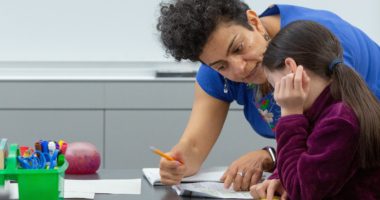What Students Have to Gain From the Arts
“The simple fact is, every child in this country needs and deserves access to the subjects that go into being a well-rounded, well-educated person. Music and art; world language; physics, chemistry, and biology; social studies, civics, geography and government; physical education and health; coding and computer science – these aren’t luxuries that are just nice to have. They’re what it means to be ready for today’s world.” – U.S. Secretary of Education John B. King
Reading Brooke Haycock’s “A Tale of Two Seventh-Graders” speaks to the impact that arts education can have on a student — from increasing such academic skills as spatial reasoning and higher-level thinking to developing essential social skills like risk-taking, self-confidence, and empathy. As a music teacher in a Title I elementary school, I realize these truths with my students as they overcome adversity in group dance projects, deepen their creativity when improvising a melody on the xylophone, and grow their critical thinking skills when categorizing classical works.
Beyond a single classroom such as mine, advocates, families, educators, and policymakers committed to education equity must also remain committed to having the arts our schools.
Why?
Because low-income students often have the most to gain from an arts-rich curriculum.
A report from the National Endowment for the Arts shows that low-income students with a high level of arts experience in school are more likely to pursue college, vote, and volunteer in their community. Further, studies on socioeconomic status and the arts have found that the relationship between arts participation and academic achievement is strongest for the lowest income students. Here’s how:
- English learners who took part in arts experiences in high school were more likely to enroll in college.
- Middle school students in drama and visual arts programs were less likely to encounter behavioral challenges or engage in risky behaviors.
- Six-year-olds from economically disadvantaged and bilingual households and enrolled in a music program had more developed auditory skills and more quickly processed language and speech than their peers who were not enrolled in a music program.
Each of these studies makes one thing quite clear: We cannot afford to lose the arts in our schools — especially high-need schools. Whether it is an eight-year-old English language learner using music to increase their language comprehension or a 12-year-old participating in after-school theater instead of getting into drama on the streets, the arts are an important piece of a child’s educational experience.
We saw it first-hand at Charles R. Drew Charter School and Graham Road Elementary School, previous recipients of our Dispelling the Myth Award. Both schools serve large percentages of low-income students and students of color, and when they received the award, both credited the integration of the arts into rigorous reading, math, and science curricula for their success in promoting critical thinking skills, teamwork, creativity, and community engagement.
The data make it clear that the arts impact students’ lives. The seventh-grader in Brooke’s piece embodies it on the brightly lit stage. Secretary King witnesses it in schools across the country. And I see it on the smiling faces and blossoming minds of students in my classroom each and every day.
Matthew Stensrud was a communications intern with Ed Trust in summer 2016. This fall, he begins his seventh year teaching music at an elementary school in Virginia.
Photo credit: Wikimedia











